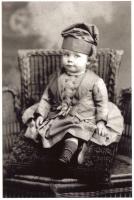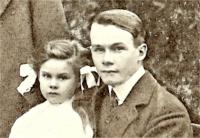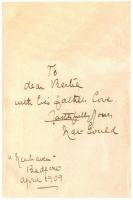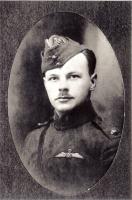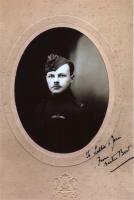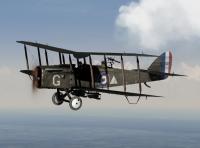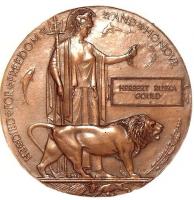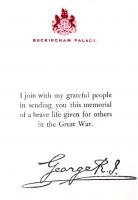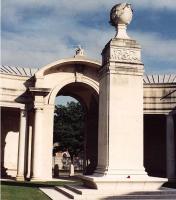
Nat Gould
His life and books
Herbert Ruska Gould
| Herbert Ruska Gould |
|---|
| Born: 1891 Sydney, Australia |
| Died: 1918 Near Douai, France |
| Father |
| Nat Gould |
| Mother |
| Elizabeth Madeline Ruska |
| Siblings |
| Edith Mary Gould |
| Sidney Nathaniel Gould |
| Doris Isabel Gould |
| Frederick William Gould |
| Winifred Madeline Gould |
| Gladys Dorothy Gould |
| Norman Henry Gould |
Herbert Ruska Gould was born in Sydney, Australia on 23 December 1891, the second son of Nat Gould and his wife Elizabeth Madeline Gould (nee Ruska).
He came to England in 1895 with his parents, elder brother Sidney Nathaniel Gould, and baby sister Doris Isabel Gould.
The family settled at Newhaven, Bedfont, Middlesex. Herbert Ruska Gould, along with his elder brother, was sent a short distance across the river Thames to Highfield School in Chertsey.
After leaving school, Herbert Gould worked as a clerk in an oil firm in the City, and was employed there and living at home in Bedfont aged nineteen years in 1911.
On publication of his autobiography The Magic of Sport 1909, Nat Gould gave a copy of the book to his son, inscribed "To dear Bertie With his father's love Faithfully Yours Nat Gould" (1).
When the First World War broke out in 1914 Herbert Ruska Gould enlisted in the City of London Yeomanry as a private soldier.
He transferred to the Royal Flying Corps, which in 1918 became the Royal Air Force, serving in 18th Squadron and attaining the rank of Captain.
He had his photograph taken in Royal Flying Corps uniform. This would be for his parents, and proud they must have been of him. He also sent a more informal copy "From Brother Bert" to his sister-in-law Alice (Lallie) Gould, wife of Sidney Nathaniel Gould, and her young daughter Joan (2). As neither Sidney Nathaniel Gould nor their second daughter Stella Alice Gould are mentioned, the photograph would have been taken between 7 October 1917 (when Sidney embarked for India) and 23 May 1918 (when Stella Alice was born).
On the Western Front in France, as Flight Commander of the 18th Squadron, Herbert Ruska Gould flew a De Havilland DH4 plane, A7989 from March 1918 and A8000 from the following May.
He achieved six confirmed victories in the air, shooting down an Albatros D.V. over Bihucourt at 1710 hours on 26 March 1918, two Pfalz D.III planes over Estaires at 1025 hours on 12 April 1918, another Pfalz D.III over Estaires at 1150 hours on 9 May 1918, a fourth Pfalz D.III over Douai at 1050 hours on 31 July 1918, and a Fokker D.VII west of Douai at 1050 hours on 9 August 1918.
He was reported missing in action near Douai on 14 August 1918, together with his gunner observer Second Lieutenant Ewart William Frederick Jinman (3). He was 26 years and eight months old.
Captain Herbert Ruska Gould was awarded a posthumous Military Cross in September 1918. The citation read as follows: “For conspicuous gallantry and devotion to duty. He has carried out 24 successful bombing raids, several of which he has led, and 26 low reconnaissance and bombing flights, as well as many low-flying, harassing and bombing patrols, during which many direct hits have been obtained and severe casualties inflicted. He has destroyed three enemy machines and has shown a very high spirit of zeal throughout” (4).
Nat Gould’s next published book bore an inscription to his dead son:
"TO THE MEMORY OF MY SON CAPTAIN HERBERT R. GOULD M.C. R.A.F. FLIGHT COMMANDER 18th SQUADRON Killed in Action on the Western Front, August 1918" (5).
Herbert Ruska Gould has no known grave, but his name is included on the Flying Services Memorial at Arras in northern France. The memorial was designed by Sir Edward Lutyens with sculpture by Sir William Dick Reid, both eminent designers, and was unveiled on 31 July 1932. The memorial bears nearly 1000 names.
Herbert Ruska Gould is also commemorated by a now barely visible inscription on his father’s gravestone at Bradbourne in Derbyshire.
(1) After the death of Herbert Ruska Gould, the book was given to his young sister Winifred Madeline Gould, who in turn passed it on to her granddaughter. Sadly it was destroyed in the Australian bush fires which raged in the state of Victoria in 2009. Fortunately, however, the inscription page had been photographed.
The inscription shows a tender side to Nat Gould's character, away from from his public image. In his autobiographical writings he tells little about his inner life. Perhaps in life he disliked showing emotion - the surprisingly formal ending of the inscription suggests that - but clearly he loved his son deeply. He must have been very proud of "Bertie* and devastated by his heroic and tragic early death.
(2) Both photographs are now in the possession of his great-niece, granddaughter of Sidney Nathaniel Gould who saved and would have treasured both pictures.
(3) His gunner/observer Ewart William Frederick Jinman was only eighteen years old.
(4) The London Gazette 16 September 1918.
(5) The book was Nat Gould's novel The Sweep Winner, published in 1920 by John Long. The same inscription also appeared in the 1920 edition of The Runaways, originally published by Everett in the 1903 issue of the Annuals by Nat Gould. The 1920 edition of Settling Day also carried a similar inscription.
